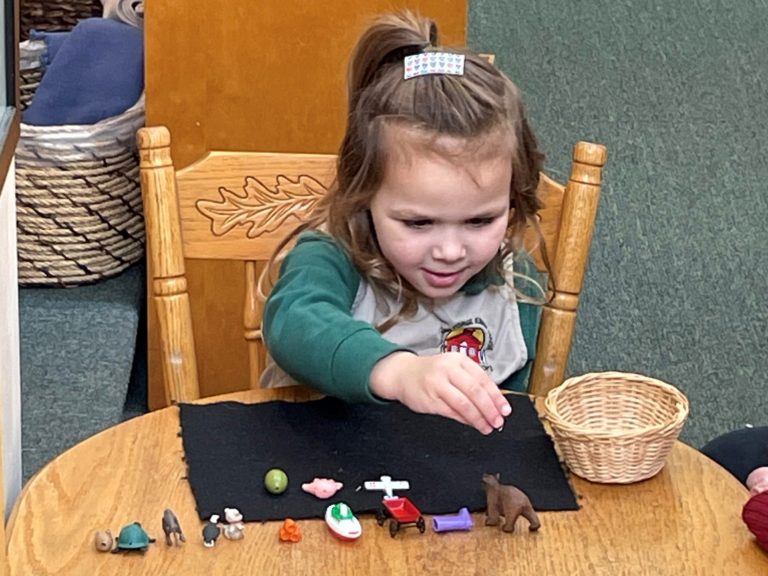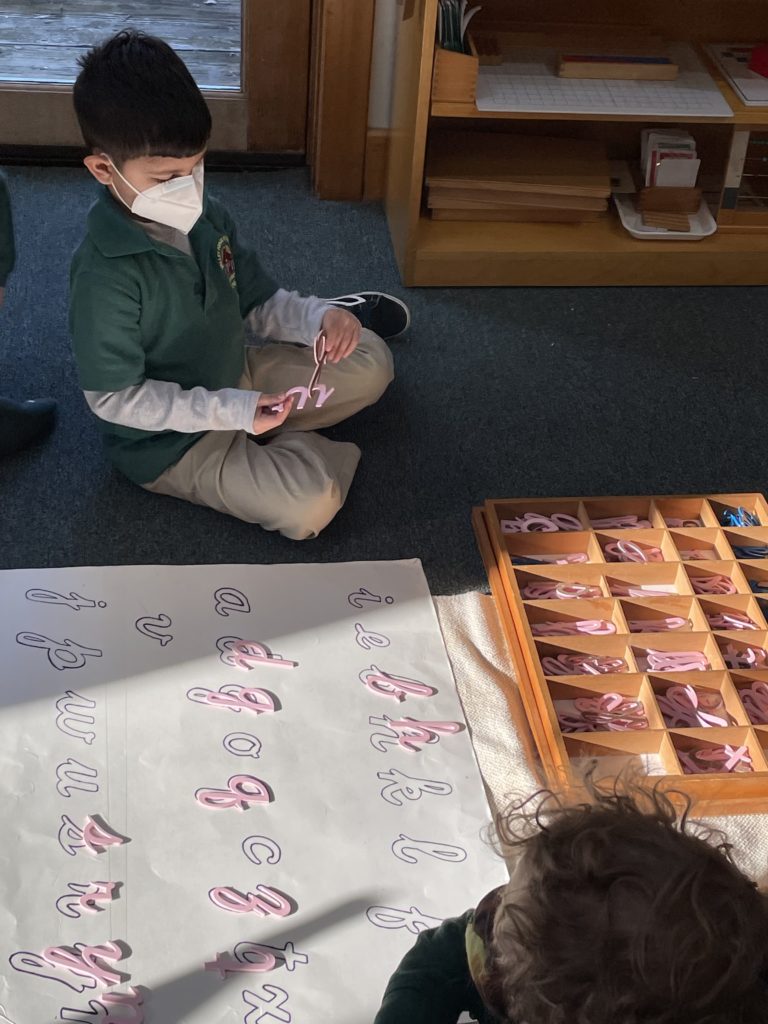
The Alphabetic Principle is the concept that letters are used to represent individual phonemes in spoken words. We want our children to understand there is a systematic relationship between speech sounds and printed letters.
The two important foundations of the alphabetic principle are Letter Knowledge and Phonemic Awareness. The skills required for understanding the alphabetic principle build the foundation for phonics. Research shows that alphabet knowledge is a strong predictor of later literacy achievement, so this is an important area we definitely don’t want to skip!
Below are five tips to be aware of when helping your child learn the alphabet.
Introduce Letter Sounds Then Letter Names

In our class, we always introduce the sounds of the letters first. When they have these sounds established then we introduce the name of the letter as well.
Research done by Piasta and Wagner (2010b) shows that letter name learning, when combined with letter-sound instruction, may causally impact students’ letter-sound acquisition.
If you’ve already been doing a lot of phonological and phonemic awareness practice, your child will be familiar with speech sounds even if they’re not familiar with letter names yet. Now you’re giving them a visual letter to attach to each sound.
Make sure to point out how your mouth forms when saying the sound represented by each letter, especially for the vowels.
Vowels make both long and short sounds, but when guiding your child, it’s important to stick with the short sounds only in the beginning. For example:
- A=apple (not acorn)
- E=Ed (not eat)
- I=itch (not ice cream)
- O=octopus (open)
- U=umbrella (not unicorn)
You’ll also want to look out for any vowels that have the letter “R” after them, as this will change the sound. For example: Don’t use “orange” for the short vowel sound “o”. The letter “o” and “r” at the beginning of that word say “or”.
Stick with the most common sound of each letter. A few to look out for when choosing alphabet cards or books. For example, ”C” is for the beginning sound in caterpillar, not city. “G” is for the beginning sound in gorilla, not giraffe, and “X” is for the last sound in fox, not the beginning sound in xylophone or x-ray.
Don’t choose words with digraphs such as “S” is NOT the first sound in the word shell and “C” is NOT the first sound in “chat”.
Teach Lowercase First and Then Uppercase Letters Directly Afterwards

In Montessori school, we teach the sounds using lowercase cursive letters first. Therefore, our children learn to write before reading words. They begin to use the moveable alphabet for writing words once a child is very familiar with all of the cursive letters and sounds.
After a child has used the moveable alphabet for months, we often introduce print by using lowercase first and then uppercase shortly after. Although uppercase letters are easier for children to write in the beginning, it is the lowercase letters that your child will see most often for sounding out words in books for reading.
Don’t Follow a Letter of the Week Pattern
This type of teaching is so outdated that it doesn’t help a child with the retention of the letters. It may be a wonderful way for learning the alphabet song, but not for truly learning the letters. It is better to stick with three letters at a time. However, there really isn’t a truly established order that everyone can agree upon based on research. We usually do these letters in small groups such as:
(s, a, t), ( i, p, n), (c, h, e), (k, r, m), (d, g, o), ( l, f, b), (q, u, j), (z, w, v), (y, z, plus other letter for practice)
Introducing Digraphs
These include two different letter sounds that are combined together to make a new sound. For example, sh, th, wh, ch, and the various short and long vowel sounds.
Short Vowels
- a – like in cat and ai in plaid
- e – like in egg and ea (bread), u (bury), ie (friend), ai (said), a (many), eo (leopard), ei (heifer), ae (aesthetic), ay (say)
- i – like in igloo and e (england), o (women), u (busy), ui (build), y (hymn), ie (sieve)
- o – like in octopus and a (swan), ho (honest)
- u – like in mug and o (monkey), oo (flood), ou (trouble)
- oo – like in book and u (bush), ou (could), o (wolf)
Long Vowel
- a – like ai in snail and a (baby), eigh (weigh), aigh (straight), ay (hay) et (croquet), ei (vein), au (gauge), a-e (cake), ea (break), ey (they)
- e – like ee in bee and e (me), ea (seat), y (lady, ey (key), oe (phoenix), ie (brief), i (ski), ei (receive), eo (people), ay (quay)
- i – like in spider and y (fly), igh (night), ie (pie), uy (buy), ye (rye), ai (aisle), is (island), eigh (height), i-e (kite)
- o – like oa in boat and o-e (bone), o (open), oe (toe), ow (low), ough (though), eau (beau), oo (brooch), ew (sew)
- u – like oo in moon and ew (screw), ue (blue), u-e (flute), oe (shoe), ough (through), ui (fruit), o (who), oeu (manoeuvre), ou (croup)
- u, y, y-u or yu-like in uniform and you (you), ew (few), iew (view), eau (beauty), ieu (adieu), eu (feud), yu (yule), eue (queue)
- oi – like in coin and oy (boy), uoy (buoy)
- ow – like in cow and ou (shout), ough (bough)
- e-Schwa sound – like er in ladder and ar (dollar), our (hour), or (doctor), i (dolphin), e (ticket), u (castus), ur (augur), er (center), eur (chauffeur)
“R” Controlled Vowels
- long a – like air in chair and are (square), ear (pear), ere (where), eir (their), ayer (layer)
- short a – like in car and a (bath), au (laugh), er (sergeant), ear (heart)
- silent ur – like in bird and er (term), ur (burn), ear (pearl), or (word), our (journey)
- short o – like in paw and a (ball), or (fork), oor (door), ore (more), oar (board) our (four), augh (taught), ar (bar), ough (bought), au (sauce)
- long e – like ear in ear and eer (steer), ere (here), ier (pier)
- u_e – like in cure and our (tour)
Always Make Learning Concepts Through Interesting Play
Learning concepts of any kind can be fun for children if you do not drill them. Use as much hands-on experiences as you can by using objects or pictures when working with sound games or letter recognition activities.